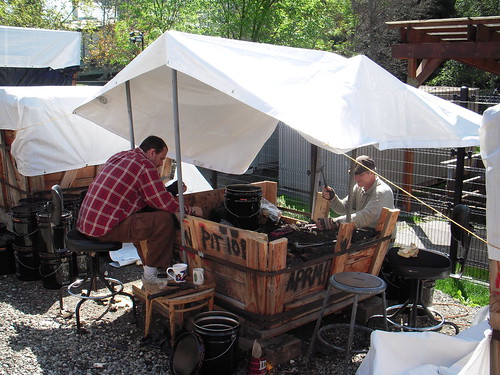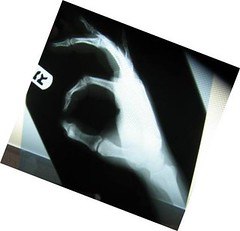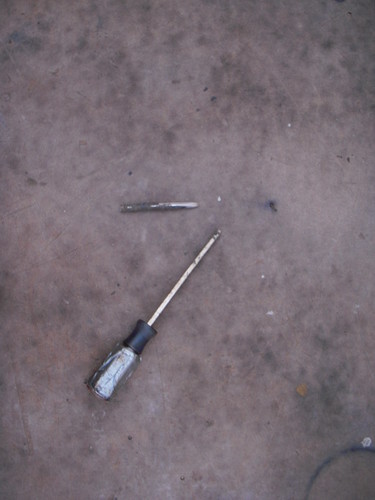What is a fossil? One of our readers, "Duys" in Belgium recently reminded me of how one can determine a fossil and I thought it a good time to bring it up. I'll meet that idea in a round about way here:
The other day, I held the back door for a family visiting the museum. One of them was in a wheel-chair and since the back (staff) door is nearest the parking lot, could enter there. Anyway, I was heading into the lab and so held that door open too so that they could get a peek inside at Shelley and the volunteers eating lunch and glimpse behind the scenes fossil workstations. The older gentleman pushing the wheelchair asked me if I was a fossil... "I'm getting there," I replied. (Yes, the LME turns 30 in less than a month.) This question the gentleman asked was not one we get often, but we are very often asked if the bones and other previously living materials we dig out are, in fact, "fossils."
Strictly speaking, it depends on your definition of the word fossil. When I took Invertebrate Paleontology, my professor, in the first week, was discussing some common mistakes & misconceptions in word definitions. One he mentioned was archaeology vs. paleontology, between which this blogs readers surely already distinguish the differences and similarities (yes?). Another he discussed was the difference between "fossil remains" and "recent remains," as well as how to tell if what you have is a fossil. Being a geologist, he discussed the difference in whether or not the remains had undergone mineralization. He noted that a fossil will not smell if you hold fire to it. Furthermore, if you stick your tongue to a "recent" bone it will stick a bit, but it won't with a "fossil" bone.
Geologists and dinosaur paleontologists often use this sort of "mineralisation" definition, but how do La Brea bones hold up to it? Since they do still contain collagen, Rancho La Brea bones would, hypothetically, still produce a burning organic smell if we held them to fire. And, yes, ones tongue would likely stick to them if tried, but that may be more due to the asphalt than the collagen.
So I've decided to test these hypotheses with a personal experiment. (Of course, I am not serious.) We don't need to burn or lick these bones to determine that they have collagen, as studies have already used collagen samples from many of the bones in attempts to extract proteins and DNA.
So, are they not fossils?
A 30,000 year old bone is a fossil, no matter how you slice it. Ancient Rancho La Brea bones, plant, shells, and insect parts all fall under the more encompassing definition of fossil provided to us by thefreedictionary.com:
"A remnant or trace of an organism of a past geologic age, such as a skeleton or leaf imprint, embedded and preserved in the earth's crust."
The Rancholabrean North American Land Mammal Age (named for our site) spans from
300,000 to 11,000 years BP, so being of a past geologic age, our remains in this time frame are fossils.
Here is a question for you all:
Are the bones, plants, shells, insect parts, etc., that we find and can date to less than 11,000 YBP fossils? Pit 10 contained a vent of remains, for example, dated at around 9,000 years. So these are not technically from "a past geologic age." Are these bones not fossils?
Since Andrea alluded to it in a previous post, I have to mention that a month ago I sprained my left wrist when I rode the top of a ladder to the ground...backwards and downwards, and slam. I have missed my left hand terribly and promise to never take it for granted again if it works with me on the physical therapy and retains full functioning.
Lawyers need not contact me, as the staff here and NHM human resources department have been caring and accommodating.
Oh, and FYI:
We've completed excavation of Box/deposit 10B; our first box finished. It went pretty fast because it was a disturbed (mostly fallen apart) deposit and we did not measure out any bones or use a grid system on it. We will not, be changing the project name to Project 22, but the thought crossed our minds.
24 March 2009
Note from the Lone Male Excavator:
11 March 2009
help for the budding scientist
Earlier this week I received the following email from a future paleontologist, Adrienne:
Hey, Andie, I have to do a science fair experiment... the kind where you have to answer a question like, "What different fruits and veggies have more vitamin C?" (That's an example, I did it in 5th grade (2nd place!))
Anyway, I have been searching the interweb and have been so far coming up blank. I was wondering if you guys had any ideas, anything that you remember possibly doing?
We never had science fairs at my school, so I have no suggestions for young Adrienne. But you, dear readers -- any ideas? If so, please comment away
07 March 2009
weekly update/in the news: we're on basic cable!
Lab assistant Trevor Valle made a totally awesome -- personable, even -- appearance on G4's "Attack of the Show" this week. Clip is embedded below!
Trevor had a great time, Kevin was a great interviewer, and we're hoping this'll turn into a recurring thing. Their studios are across the street, after all...
Meanwhile, back at the project...
We've taken a break from the large deposit -- Box 1 -- to focus on the little crate that could -- Box 10B. It's about 5' x 5' x 4' deep, and filled with wonderfully soft and squishy asphaltic sand and dirt -- SO much easier to excavate than Box 1. Not nearly as dense a deposit as Box 1, but we have found a wide range of rodent, rabbit and bird bones (including a beak), some dermal ossicles, and the jaw of a dwarf pronghorn. We're making quick work of this deposit; it's been open for about a month, and we're already more than half way done with it. Two things to note in this picture:
1) Check out the awesome lean-to that volunteer Richard Simun rigged up out of spare parts strewn about the excavation compound. We are well-shaded and sunburn-free!
2) The box was originally 2' taller than it is in the photograph; we've been removing slats from the tree box as we dig down. We'll be doing this for all of the deposits. It makes it easier to dig, and easier for the public to get a look at what we're digging.
Things you can't see in the picture above -- Ryan sprained his left wrist! But fortunately, he is going to be...
...a-ok. He's out of town now, but will have a "Note" on that sometime next week.
And though the sediment is a lot softer than that in Box 1 (I'm sitting next to it right now, with Spencer Bronte digging -- he just found a big bird bone!), it's not without its hazards:
I broke two screwdrivers this week while chiseling. Good time to test Craftsman's warranty, eh?





